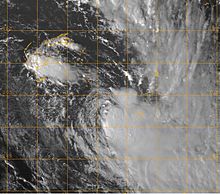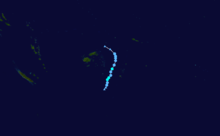- Cyclone Hettie (2009)
-
Tropical Cyclone Hettie Category 1 cyclone (Australian scale) Tropical storm (SSHS) Tropical Cyclone Hettie just before it was named Formed January 24, 2009 Dissipated January 31, 2009 Highest winds 10-minute sustained:
75 km/h (45 mph)
1-minute sustained:
65 km/h (40 mph)
Gusts:
95 km/h (60 mph)Lowest pressure 993 mbar (hPa; 29.32 inHg) Fatalities None Reported Damage Minimal Areas affected Rotuma, Tonga. Part of the 2008–09 South Pacific cyclone season Tropical Cyclone Hettie (RSMC Nadi Designation: 08F, JTWC Designation: 11P) was the first named tropical cyclone in the South Pacific since Cyclone Gene of 2008. Late on January 24, the Regional Specialized Meteorological Centre in Nadi, Fiji, reported that a weak tropical disturbance had formed within a monsoon trough, to the north of the Fijian dependency of Rotuma. The next day after the disturbance had made landfall on Rotuma, it was designated as Tropical Depression 08F. A Tropical Cyclone Formation Alert was released by the Joint Typhoon Warning Center (JTWC), early on January 27. The depression was not upgraded to a tropical cyclone until the next day when it was named as Hettie by RSMC Nadi whilst the JTWC designated Hettie as Tropical Cyclone 11P. As Hettie moved towards the southeast it did not intensify any further and was downgraded to a depression the next day. Over the next couple of days it moved slowly towards the southeast and slowly weakened before being downgraded to an area of low pressure late on January 31. There was very little damage from Cyclone Hettie on Rotuma and in Tonga with 55.8 mm of rainfall falling on Rotuma during January 24 and January 25. There was also no deaths reported within Fiji or within Tonga.
Contents
Meteorological history
On January 24, 2009, the Regional Specialized Meteorological Centre in Nadi, Fiji, reported that a weak tropical disturbance had formed to the north of the Fijian dependency of Rotuma.[1] At this time the disturbance was located within a Monsoonal Trough, and in an environment of low vertical wind shear.[1] Early on January 25, the tropical disturbance made landfall on Rotuma with winds of 35 km/h (25 mph).[2] Later that day RSMC Nadi reported that the disturbance had organised enough to be classified as Tropical Depression 08F.[3] During the afternoon of January 26 the Joint Typhoon Warning Center (JTWC) reported that the low level circulation center, was located within an area of moderate vertical wind shear.[4] They also reported that animated infrared imagery had shown that deep convection was flaring on the eastern boundary of the low level circulation center.[4]
Early the next day, RSMC Nadi reported that there was a moderate to high chance of the tropical depression intensifying into a tropical cyclone within 24 hours.[5] This was because good outflow channels existed to the north and south of the depression which were aiding the development of the depression.[5] Later that morning the JTWC issued a Tropical Cyclone Formation Alert on the depression, as animated multispectral imagery had indicated that the depression had a well-defined but wide low-level circulation center.[6] They also reported that the convection was sheared to the east of the low level circulation center and predicted that an upper level trough that was to the west of the system could allow convection to build over the low level circulation center.[6]
During the morning of January 28, RSMC Nadi reported that Tropical Depression 08F had intensified into Tropical Cyclone Hettie, they also reported that there was a possibility that Hettie could intensify further.[7] However this did not occur and thus Hettie was a minimal Category One Tropical Cyclone on the Australian Tropical Cyclone Intensity Scale, at its peak, with winds of 65 km/h (40 mph).[8] Later that day the JTWC designated Hettie as Tropical Cyclone 11P, and reported that Hettie had peak one-minute sustained winds of 65 km/h (40 mph).[9] Early on January 29, the JTWC released their last advisory on Cyclone Hettie, whilst RSMC Nadi downgraded Cyclone Hettie to Tropical Depression 08F ex Hettie.[10][11] Later that day RSMC Nadi reported that the depression had reached its secondary peak winds of 65 km/h (40 mph) to 75 km/h (45 mph).[12] However they did not re-upgrade it to a Category One Cyclone as gales did not extend more than halfway around the center of the depression, thus they continued to call Hettie a depression.[12] Over the next couple of days the depression moved towards the northwest and weakened before RSMC Nadi released their final Tropical Disturbance Summary late on January 31, as the depression had lost all its tropical characteristics and lied under an upper-level trough of low pressure.[13][14]
Preparations and impact
Early on January 27, RSMC Nadi started to issue Special Weather Bulletins for Tonga, within them they issued a tropical cyclone gale alert for central and southern parts of Tonga.[15] However later that day RSMC Nadi cancelled the issuance of the Special Weather Bulletins for Tonga as it was now moving to the southwest, and was no longer expected to recurve towards Tonga.[16] On January 29, the Tongan National Disaster Office reported that there had been no reports of any major damage or deaths within Tonga from Hettie.[17] Between January 24 and 25, 55.8 mm (2.19 inches) of rain fell on Rotuma. Despite the center of the disturbance passing directly over the island, there were no reports of damage.[18]
See also
- 2008–09 South Pacific cyclone season
- Timeline of the 2008–09 South Pacific cyclone season
References
- ^ a b "Tropical Disturbance Summary 24-01-09 21z". Fiji Meteorological Service. 2009-01-24. http://www.webcitation.org/5e4uRBsIY. Retrieved 2009-01-28.
- ^ "Tropical Cyclone Track and Threat Map 24-01-2009 12z". Fiji Meteorological Service. 2009-01-24. http://www.webcitation.org/5eAdWIEjt. Retrieved 2009-01-28.
- ^ "Tropical Disturbance Summary 25-01-09 21z". Fiji Meteorological Service. 2009-01-25. http://www.webcitation.org/5e6X02Z07. Retrieved 2009-01-27.
- ^ a b "Significant Tropical Weather Advisory for the Western and south pacific Oceans". Joint Typhoon Warning Center. 2009-01-26. http://www.webcitation.org/5e7SdsCkb. Retrieved 2009-01-28.
- ^ a b "Tropical Disturbance Advisory 27-01-2009 00z". Fiji Meteorological Service. 2009-01-27. http://www.webcitation.org/5e89Be6FO. Retrieved 2009-01-29.
- ^ a b "Tropical Cyclone Formation Alert". Joint Typhoon Warning Center. 2009-01-27. http://www.webcitation.org/5e89LVk6z. Retrieved 2009-01-27.
- ^ "Tropical Disturbance Advisory 28-01-2009 09z". Fiji Meteorological Service. 2009-01-28. http://www.webcitation.org/5eAC7aBkK. Retrieved 2009-01-31.
- ^ "Tropical Disturbance Advisory 29-01-2009 00z". Fiji Meteorological Service. 2009-01-29. http://www.webcitation.org/5eBG8fpAL. Retrieved 2009-01-31.
- ^ "Tropical Cyclone 11P, Warning one". Joint Typhoon Warning Center. 2009-01-28. http://www.webcitation.org/5eAMxtRT5. Retrieved 2009-01-31.
- ^ "Tropical Cyclone 11P, Warning Two". Joint Typhoon Warning Center. 2009-01-28. http://www.webcitation.org/5eBGE1Ap0. Retrieved 2009-01-31.
- ^ "Tropical Disturbance Advisory 29-01-2009 06z". Fiji Meteorological Service. 2009-01-29. http://www.webcitation.org/5eBc9Afzo. Retrieved 2009-01-31.
- ^ a b "Tropical Disturbance Summary 30-01-09 21z". Fiji Meteorological Service. 2009-01-30. http://www.webcitation.org/5eDHIJLkK. Retrieved 2009-01-31.
- ^ "Tropical Disturbance Summary 31-01-09 09z". Fiji Meteorological Service. 2009-01-31. http://www.webcitation.org/5eFV94ZgL. Retrieved 2009-01-31.
- ^ "Tropical Disturbance Summary 31-01-09 21z". Fiji Meteorological Service. 2009-01-31. http://www.webcitation.org/5eFYZp89s. Retrieved 2009-01-31.
- ^ "Special Weather Bulletin Number one for Tonga issued from RSMC Nadi". Fiji Meteorological Service. 2009-01-27. http://www.webcitation.org/5e89xLm1m. Retrieved 2009-01-31.
- ^ "Special Weather Bulletin Number Seven for Tonga issued from RSMC Nadi". Fiji Meteorological Service. 2009-01-27. http://www.webcitation.org/5e9Sj6A0n. Retrieved 2009-01-31.
- ^ "Little damage in Tonga after high winds". Radio New Zealand. 2009-01-29. http://www.rnzi.com/pages/news.php?op=read&id=44469. Retrieved 2009-01-31.
- ^ "Preliminary rainfall data for January 2009". Fiji Meteorological Service. 2009-02-03. http://www.webcitation.org/5jduapW10. Retrieved 2009-09-08.
External links
Categories:- Tropical cyclones in Fiji
- Tropical cyclones in Tonga
- 2009 in Fiji
- 2009 in Tonga
- Category 1 South Pacific cyclones
- 2008–09 South Pacific cyclone season
Wikimedia Foundation. 2010.


